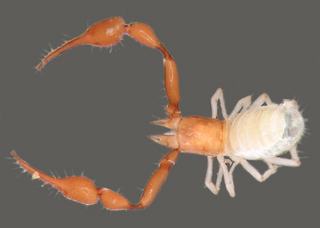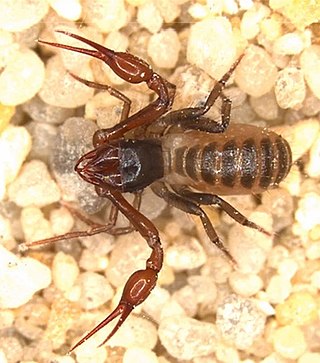
Pseudoscorpions, also known as false scorpions or book scorpions, are small, scorpion-like arachnids belonging to the order Pseudoscorpiones, also known as Pseudoscorpionida or Chelonethida.
Feaella is a genus of pseudoscorpions in the family Feaellidae, first described by Edvard Ellingsen in 1906.
The Sternophoridae are a family of pseudoscorpions with about 20 described species in three genera. While Afrosternophorus is an Old World genus, found mainly in Australasia, the other two genera are found in the New World, from El Salvador to the southern USA and in the Dominican Republic.

Joseph Conrad Chamberlin was an American arachnologist who studied mainly pseudoscorpions. A native of Utah, he studied primarily at Stanford University while working most of his career in Oregon for the U.S. Department of Agriculture. Several species are named in his honor.

Lechytia is a genus of pseudoscorpions in the subfamily Lechytiinae within the family Chthoniidae. It is the sole genus in its subfamily and contains 22 described species from many parts of the world.

Chthoniidae is a family of pseudoscorpions within the superfamily Chthonioidea. The family contains more than 600 species in about 30 genera. Fossil species are known from Baltic, Dominican, and Burmese amber. Chthoniidae now includes the former families Tridenchthoniidae, and Lechytiidae which has been demoted to subfamilies.
Compsaditha is a genus of pseudoscorpions in the family Chthoniidae. There are about 12 described species in Compsaditha.
Garypus titanius, the giant pseudoscorpion, is the largest species of pseudoscorpion—small, scorpion-looking creatures—in the world. Critically endangered, it is restricted to Boatswain Bird Island, a small rocky island off Ascension Island in the South Atlantic Ocean. Pseudoscorpions are venomous arachnids and are generally tiny—around 3 mm long. The giant pseudoscorpion, though, can grow to five times that size at 11 mm. It lives among seabird colonies, feeding mainly at night on smaller prey such as insects. It belongs to the Garypidae family.
Austrochthonius insularis is a species of pseudoscorpions in the family Chthoniidae.
Cryptocheiridium is a genus of pseudoscorpions in the Cheiridiidae family. It was described in 1931 by American arachnologist Joseph Conrad Chamberlin.

Syarinidae is a family of pseudoscorpions in the order Pseudoscorpiones. There are at least 20 genera and 110 described species in Syarinidae.
Ideoroncidae is a family of pseudoscorpions belonging to the order Pseudoscorpiones. Members of the family are known from Asia, Africa, western North America and South America.

Pseudotyrannochthoniidae is a family of pseudoscorpions, belonging to the superfamily Chthonioidea. It represents the most basal and primitive group of living pseudoscorpions, with less than 100 species in 6 genera. Living members of the group have a strongly disjunct distribution, likely reflecting ancient vicariance, occurring in Australia, Asia, Southern Africa and Madagascar, Western North America and southern South America. Fossils species are known from the Eocene Baltic and Bitterfeld amber, which represent members of extant Asian genera.
Austrochthonius is a genus of pseudoscorpions in the family Chthoniidae. It was described in 1929 by American arachnologist Joseph Conrad Chamberlin.

Tyrannochthonius is a genus of pseudoscorpions in the family Chthoniidae. It was described in 1929 by American arachnologist Joseph Conrad Chamberlin.
Sathrochthonius is a genus of pseudoscorpions in the family Chthoniidae. It was described in 1962 by American arachnologist Joseph Conrad Chamberlin.
Austrochernes guanophilus is a species of pseudoscorpion in the Chernetidae family. It is endemic to Australia. It was described in 1967 by Austrian arachnologist Max Beier.
Pseudochiridium is a genus of pseudoscorpions in the Pseudochiridiidae family. It was described in 1906 by Danish arachnologist Carl Johannes With.







